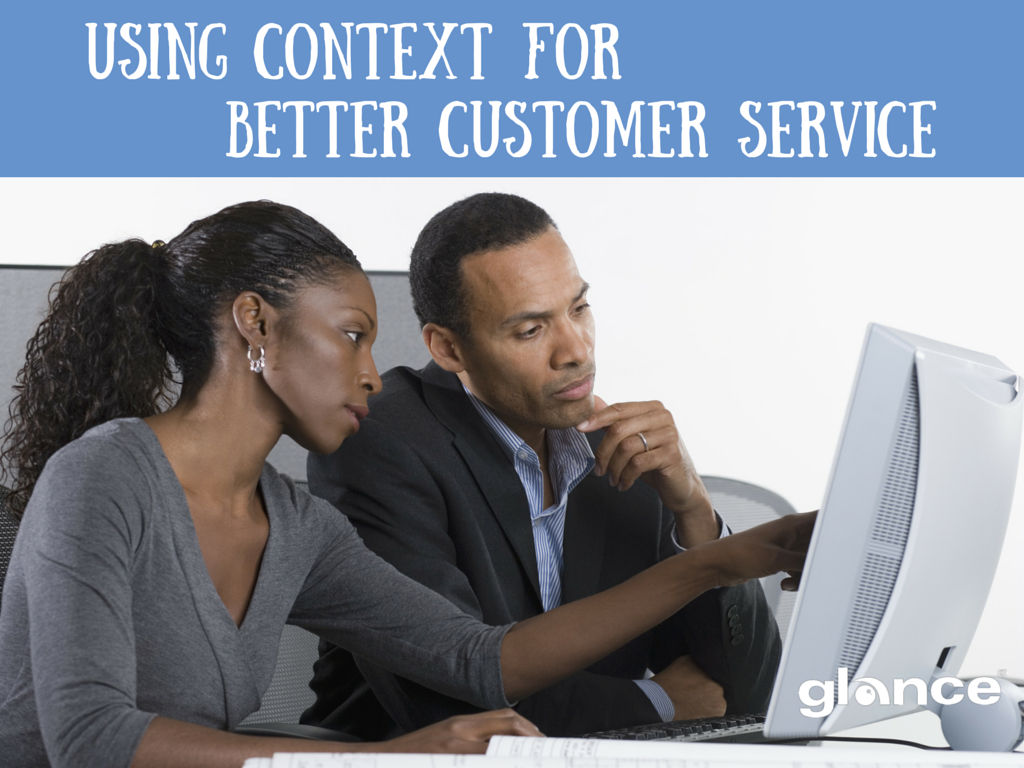This guest post was written by Rina Henderson, a seasoned UX Designer and Developer at CodeScience.
Knowing your customers and their context allows you more fully understand their needs and requirements. Ultimately, this allows you to provide better results for your customer. Grasping customer context – a set of known factors that enable you to fully understand a situation or need – early on will provide you with a definite advantage, whether you are offering online customer service, a product, or an in-person service.
User context is high on the list of what we at CodeScience typically discuss from the start of every SaaS project, because we have to know who will use what we’re designing and how they will use it. Once we understand that, we can develop a user experience that will enable our customers to provide exactly what their own customers want.
Context can be comprised of several factors, notably the who, where, why, what, and how. For example, when CodeScience teamed up with Glance Networks to help design the Glance Cobrowse solution, we first aimed to understand who users would be, what the constraints and barriers would be, why people would be motivated to use the product, and how goals and success factors would be achieved.
Read: What is Cobrowse and How is it Different From Screen Share?
Know your customers by creating personas
The pieces that we use to map out and understand user context are called artifacts. In SaaS user experience (UX) design, artifacts (often also called deliverables) are anything that can be used to help convey design function, use, and intention. Examples of artifacts include personas, scenarios, and more. At CodeScience we usually start our journey by developing user personas, or people who might use the product we’re working on.
Personas can look different depending on the type of project or initiative you’re designing. Information about personas is used to expose a narrative not simply for the sake of telling a story, but to reveal real users, with real needs, who must complete real tasks.
In order to make the stories realistic, you should try to understand a little bit about your personas. For example, where will they be using the product/solution and why will they will be using it? You can even expand persona information by capturing skills, preferences, demographic details, and any other information that may be helpful to describe the profile of a user.
When we were working on Glance Cobrowse, we used this basic format:
- Who will use Glance Cobrowse: customer service rep
- Where will they use it: inbound call system
- Why will they use it: to help customers who run into issues while trying to make a website purchase
Another Glance Cobrowse persona example was the customer who is trying to make the purchase on a shopping website so they can purchase a gift. Yet another example would be a system admin who is in a Customer Relationship Management (CRM) system like Salesforce, initializing the sales and service environment for their internal users, such as the customer service reps who will use the system to take inbound calls.
Read: Cobrowse and Screen Share: Are You Ready to Get On Board?
Multiple personas could very well be interrelated and play into a single project. When working with Glance, for instance, we realized that we had to take into account two types of users who would consistently interact: a live customer on a website who needed help and a live agent available to help. The order of interaction became important to note, which is where context comes into play even further.
Expose context through scenarios
To bring context to the surface, take the personas you developed for your SaaS business and start asking questions about them in order to understand their interactions from an end-to-end perspective. What are they doing? Where are they at in the system when they are trying to accomplish their tasks? How are they accessing the system? In what physical environment are they working?
You will use the answers to these questions to build scenarios, like having actors take their places in the scene of a movie. Scenarios are sometimes combined into expanded personas or set up as the basis for extracting user stories and feature sets.
With Glance Cobrowse, we were designing for multiple personas in a tandem experience/scenario. It was important to note that agents had to set their status to “live” in order for the end customer to see that live chat was available on the website they were browsing. Once the customer could initiate a live chat, the live agent’s side of the experience was further triggered.
Empathy really comes into play at this stage of understanding. Empathy involves trying to put yourself in the persona’s shoes. Recreate the persona’s experience by exploring his or her steps and the environment he or she is in. Try to sync with his or her behavior. When you do this, you start asking the “what if” questions that will help you flesh out your scenarios and realizing the varying conditions that impact the user’s flow.
Take into account additional user experience artifacts
In addition to personas and scenarios, there are a number of artifacts you can take into account, such as user flows, customer journeys, diagrams, mockups, wireframes, and screenshots. Note that there is no single “right way” to represent artifacts, so long as they are useful to your team.
Diagramming is really helpful for visualizing flow and the sequential nature of a user’s behavior. Flow optimization can become very apparent when displayed visually. Gaps in behavior or unexpected deviations from the experience you originally designed provide a great opportunity to ask more questions and investigate the reasoning behind these areas of concern.
For Glance, we found that diagramming the tandem experience as a parallel user flow made sense, so we could highlight the back and forth interaction that was inherent in the Glance Cobrowse experience.
Our UX User Journey artifact shows an end-to-end flow of two different users, each with different contexts happening concurrently. It also highlights trigger points for key functionality in the user interface (UI) within both contexts. Though the agent and the customer were our focus in this project, the artifact includes ancillary personas, such as a Customer Relationship Management (CRM) solution admin and a basic CRM user. Each had little to do with the flow we were designing but were worth noting from a relative sense.
Some final words about artifacts
Remember that artifacts are yours to design, but they need to be useful and informative in the process of manifesting your desired outcome. You can stay lean and basic and still be fruitful with your design discovery.
You can also use any tool, from whiteboard, sketch pads, to design software. The best advice for which tools to use is stick with something you and your team don’t have a huge learning curve to use. Choose something that allows fluidity in your workflow, and ideally something collaborative (in the flow example above, we used the Google Drawing app).
Artifacts become conversation pieces during buy-in and vetting of concepts. They are working documents. If you’re in the practice of providing highly polished documentation, that’s fine, but wait till the end to button things up. You want a lot of conversation and reworking to fully validate your approach from all angles.
Keep your customers at the center of your design
The foundations of what we have covered can be applied toward a multitude of SaaS experiences including software, mobile, kiosk, phone, and in-person customer service. Whether your customers are users of something tangible like a product, are web based customers, or are interacting in a real environment, you can apply user-centered thinking and carry empathy throughout the entire process. Take your customers’ contexts into account as a part of your strategy. You will know that you’ve successfully accomplished this when your customers trust the experiences you are providing to them and continue coming back.
Are you ready to discover how Glance visual engagement solutions can improve customer engagement and increase sales for your business?
Sign up for your personalized Glance demo today!
About Glance Networks
Glance helps enterprise organizations create the ultimate customer experience with smart, omni-channel visual engagement solutions based around integrated cobrowse, screen share, and one-way agent video. We are one of the world’s simplest, most reliable and secure platforms that enable companies to see, show and share anything online, creating a frictionless path to great experiences in sales, support and customer service. The result is improved customer satisfaction and loyalty, increased revenue growth and operational savings. From financial services and healthcare to retail and travel and leisure, even the most advanced technology and SaaS organizations – we transform the customer experience for today’s business. Learn More »
About the author: Rina Henderson
Rina Henderson is a seasoned UX Designer and Developer, with a core in user interface prototyping, user experience strategy, and user-centered design. At CodeScience, she helps build delightful, intuitive, and logical experiences that flow on the Salesforce platform. You can connect with her on LinkedIn and Twitter.
SaveSave
SaveSave




